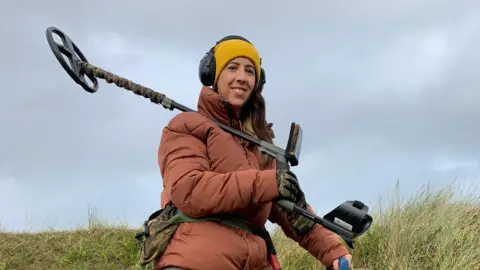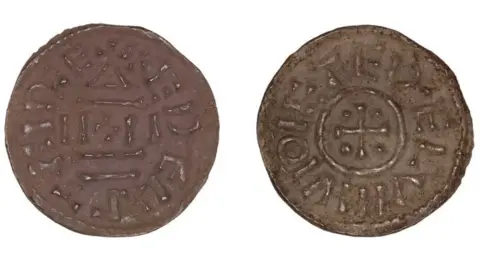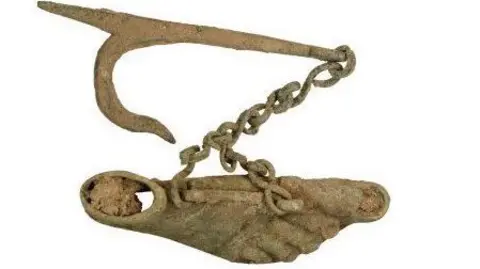 Handouts / BBC
Handouts / BBCThe treasure found in England has hit a record high, with a lamp shaped like a human leg and a scoop of earwax among the more unusual items unearthed.
Government figures recorded in the British Museum’s portable Antiquities scheme show 1,446 discoveries in England in 20,266 up to last year.
A treasure find can include many things, and the East of England is proving to be the jewel in the country’s crown, with 388 finds last year.
Much is unknown to metal detectorists like Emma Yourell, who estimates she has found thousands of artefacts and describes herself as a “Big History Nerd”.
Emma says the most valuable part of the treasure hunt is knowing that recording it contributes to our understanding of history.
“I found a hammer coin, a silver cent with a picture of Henry VIII on it – so we’re going back to the tudors.
“I have gold coins from iron age tribes – about 2,000 years old.”
For the first time, 2024 was found to include two things that meet a new definition of wealth.
Ancient treasure must be at least 300 years old and made in part of precious metal such as gold or silver, or part of a hoard.
From July 2023, it has been extended to objects that are at least 200 years old and are considered to have exceptional historical, archaeological or cultural importance, regardless of the type of metal they are made of.
The 2024 provisional figures show a further 85 treasures found in Wales and nine in Northern Ireland, with Additional restrictions to search for archaeological objects.
Scotland has a separate law for treasure trove and so the figures are not included.
Viking King’s coin
 Andrew Williams / Norfolk County Council
Andrew Williams / Norfolk County CouncilThe first under the new definition, a chapter of the 9th century in the wealth capital of England, Norfolk, with 138 found in any county.
Dr Helen Geake, Norfolk Liaison Officer, found that the area could be the best for the nationalities of the riots and good for detectorists and archectorists.
“This is the first official coin issued by Aetelstan,” he said.
“A proper government coin”.
It was split by a Viking Warlord after he became a Christian king, known as AethelStan II.
A picture of the Vikings, he said, were “attacks and raiders and attacks on monasteries – then they became the most peaceful Norse principalities.
“This coin submits the focus between the fearsome Vikings who attacked us, and the real settler vikings we are in a strange way. “
A lamp shaped like a human foot
 KENS County Council
KENS County CouncilThe second is a Roman copper lamp in the shape of sandals, discovered by a research team in Kent while exploring what is believed to be a small Roman fort.
According to Portable Place Antiquitiitit is the first known example of its type found in Britain.
A metal detectorist first saw the light chain before opening the whole thing.
“It’s the most amazing thing,” Dreake said.
“The artefacts of the Roman foot that appear to have a number of meanings connected to the cult of Isis. They are also noticed objects that have been opened.”
An earwax scoop
 NORFOLK County Council
NORFOLK County CouncilOne of Dr Geake’s favorite things is a Roman ear scoop.
“Apparently they’re used to scooping your earwax off, as if your finger wouldn’t do it,” he said.
“Perhaps this view of it is more than anyone since an owner has lost it – and it brings you a strange, such a different contact with the owner.
“It’s a beautiful thing and when I record things like this I think, I have the best job in the world’ – to look at their things and give them a new life.”
‘My Husband Knows I’m a Huge History Nerd’
 Emma youll
Emma youllEmma says she has been missing almost every week since starting the hobby 12 years ago.
The 34-year-old from Kent is the youngest of the metal-finding group and one of the only women.
Today, she sees more women and young people getting involved and helps run a facebook group for female detectives.
“I got a camper van so it allowed me to go out and across the country,” he said.
“My husband knows I’m a huge history nerd. He’s very happy for me to go on a Sunday and do what I love to do.”
He is also happy to do a “Weekender” – camping on a farm with fellow detectorists and the permission of the farmer – from Friday to Sunday.
“We all have a little barbeque or something to get together – it’s very social,” he said.
“Mass people make great friendships in the UK”.
Dr Geake believes that treasure finds are increasing in England because now there are more detectorists, more knowledge about reporting on archaeological sites.
“You can’t blame a farmer for plowing into an archaeological site they didn’t know was there,” he said.
“There are such pressures, especially on small farms.
“There should be some kind of landowners, with archaeologists, with the general public. How much do we want to save our historic environment and what resources are we prepared to put into it?”
‘We have this understanding of wealth – but we shouldn’t be limited by that’
Julian Evan-Hart from Essex, editor of Treasure Haying magazine, found his finds in museums. However, one of his favorite things is getting together with people with sentimental things.
He finds wedding rings, baby jewelry and even a Cap Badge from where an old woman’s father crashed a decade before.
“It was a small crushed piece of copper – intrinsically worthless except for the value of his daughter…
“We have this conception of wealth – gold and silver – but we should not be limited by that because the biggest, most insignificant thing of a person in one place in the world can be more in the world.
“The greatest thing about this hobby is yes, what we find, but the ability to share it with other people.”
In 2023, 1,358 treasure finds were initially recorded, which was changed to 1,343 as some finds were not resolved in the publication.
As an individual “treasure find” can be made up of many artefacts, these numbers actually represent 32,768 artefacts.
Provisional figures for the treasure found in 2024 will be confirmed in 2026 along with how many individual artefacts they include.
Additional Reporting by Jonathan Fagg


